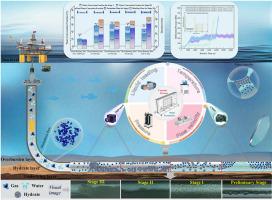Investigation of hydrate formation and flow characteristics within multiphase transmission pipelines employing a constant pressure visualization loop system
IF 5.5
0 ENERGY & FUELS
引用次数: 0
Abstract
Hydrate blockages during oil and gas transportation severely affect flow safety. An innovative, fully visual flow loop was utilized to systematically evaluate and quantify the individual effects of pressure, temperature, flow velocity, and liquid loading on hydrate formation, flow characteristics, and morphological evolution. The results indicate that hydrate growth progresses through the stages of initial formation, slurry stable flow, and aggregation and blocking, with the water conversion fraction and differential pressure exhibiting pronounced stage-dependent evolution features. Increased pressure augments the fugacity gradient, thereby reducing the hydrate formation time and blocking time, exacerbating particle aggregation, and facilitating hydrate generation. At constant pressure, high subcooling accelerates gas consumption and lengthens hydrate formation time, promoting the development of microporous aggregate network structures. The water conversion fraction increases with subcooling but remains insensitive to variations in subcooling during the blocking stage. A critical flow velocity exists, above which hydrate can continue to be transported in suspension in the main pipeline, although deadlegs remain susceptible to blockage. Furthermore, flow velocities exceeding 0.27 m/s can postpone blockage when below the critical threshold. High liquid loading delays hydrate formation time but shortens blocking time, and the maximum water conversion fraction occurs at a liquid loading of 60 vol%. During the slurry stable flow stage, hydrate conversion above this critical value is governed by particle aggregation and continued hydrate formation. These experimental findings advance the understanding of hydrate behavior in multiphase flow systems under constant pressure, providing a foundation for improving risk assessment and flow assurance strategies.

利用恒压可视化回路系统研究多相输气管道中水合物的形成和流动特性
油气运输过程中水合物堵塞严重影响流动安全。一个创新的、完全可视化的流动回路被用来系统地评估和量化压力、温度、流速和液体载荷对水合物形成、流动特性和形态演化的单个影响。结果表明:水合物生长经历了初始形成、浆体稳定流动和聚集阻塞三个阶段,水转化率和压差表现出明显的阶段依赖性演化特征;压力的增加增大了逸度梯度,从而缩短了水合物的形成时间和堵塞时间,加剧了颗粒聚集,促进了水合物的生成。在恒压下,高过冷加速气体消耗,延长水合物形成时间,促进微孔骨料网络结构的发展。水转化率随着过冷度的增加而增加,但在阻塞阶段对过冷度的变化不敏感。存在一个临界流速,超过该流速,水合物可以继续在主管道中悬浮输送,尽管死腿仍然容易堵塞。当流速低于临界阈值时,流速超过0.27 m/s可以延迟堵塞。高液体负荷延迟了水合物形成时间,但缩短了水合物阻塞时间,水转化率在液体负荷为60vol %时达到最大值。在浆体稳定流动阶段,高于该临界值的水合物转化受颗粒聚集和持续水合物形成的控制。这些实验结果促进了对恒压多相流体系中水合物行为的理解,为改进风险评估和流动保障策略提供了基础。
本文章由计算机程序翻译,如有差异,请以英文原文为准。
求助全文
约1分钟内获得全文
求助全文

 求助内容:
求助内容: 应助结果提醒方式:
应助结果提醒方式:


